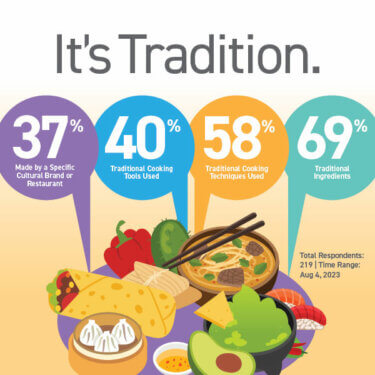A recent study by Hormel Foods* found that consumers are open to a wide spectrum of foods, transcending cultural and geographical boundaries. Over three-quarters of respondents are interested in international foods, fusion creations, and Americanized renditions of global dishes. Interestingly, only a minor fraction report aversion to any of these culinary categories, indicating a broad and inclusive palate.
International Foods
* Toluna Start survey United States sample N=209 Primary- or Shared-Responsibility Grocery Shoppers Ages 25-64 Fielded 8/4/23
Consumers are similarly positive about fusion cuisine. Those under age 55 are significantly more likely to say that they ‘love’ these types of foods compared to those 55 and older. Older consumers are more neutral about fusion food. Only a small portion of consumers report disliking fusion food.
Fusion Food
* Toluna Start survey United States sample N=209 Primary- or Shared-Responsibility Grocery Shoppers Ages 25-64 Fielded 8/4/23
Consumers also embrace Americanized versions of international foods, with nearly three quarters reporting that they ‘like’ or ‘love’ Americanized global flavors. A mere 5% of consumers dislike Americanized global flavors.
International Foods Americanized Versions
* Toluna Start survey United States sample N=209 Primary- or Shared-Responsibility Grocery Shoppers Ages 25-64 Fielded 8/4/23
The Significance of Authenticity
To discern the essence of authenticity, consumers gravitate towards traditional ingredients, spices, cooking techniques, and utensils as the foremost indicators. This prioritization highlights the attachment to the genuine essence of a dish rather than superficial attributes such as names, brand provenance, or excessive spiciness. This collective sentiment underscores the yearning for an immersive gastronomic experience rooted in the rich heritage of the cuisine.
Traditional ingredients emerge as the leading criterion for consumers when evaluating the authenticity of international foods, resonating with nearly 70% of respondents. Traditional spices and cooking techniques follow suit, suggesting an inclination towards the faithful preservation of culinary heritage. On the other hand, secondary factors like brand, restaurant type, and spice intensity assume a less pivotal role in defining authenticity.

Consumer sentiment extends to Americanized versions of international foods, with an overwhelming majority expressing positive attitudes. Nearly three-quarters of respondents favor these adaptations, dispelling concerns that cultural fusion dilutes authenticity. Merely 5% of consumers were skeptical of the fusion of flavors.
The exploration of consumer preferences for authentic food underscores the evolving nature of culinary appreciation in a globalized world. The findings highlight an open-mindedness to diverse gastronomic experiences while underlining the importance of traditional elements in defining authenticity. Moreover, the age-related variations in preferences and the eclectic range of sources for authentic recipes underscore the dynamic interplay between tradition and innovation in shaping contemporary culinary landscapes.
